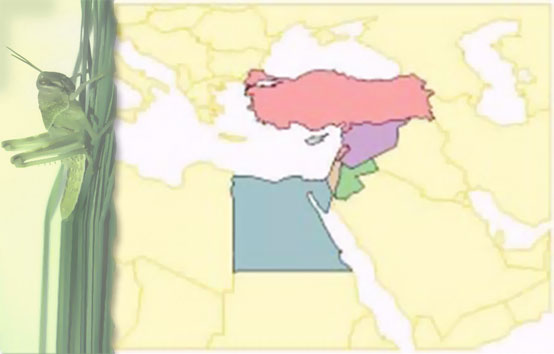Oryctes elegans Prell
Taxonomic placing: Insecta, Holometabola, Coleoptera, Scarabaeidae.
Common name: Fruitstalk borer, bunch stalk borer.
Geographical distribution: Persian Gulf states, Jordan, Israel and Egypt.
Host plants: Various palms, coconut, lawn grasses.
Life cycle: The pest has a single annual generation. Adults appear in April-May, bore into the surface of fronds and fruitstalks, remaining there till October. The eggs (about 60/female) are placed on living and dead tissues of the host trees. The larvae feed on grass roots where they pass the winter, pupating during spring in the soil. In the laboratory the beetle can be reared on decayed wood or compost with cow dung. At 28-30°C it required about 4 months to complete a generation.
Economic importance: This borer is considered a key pest of date palms in several countries. The adults bore in the fronds, rachises and fruitstalks of date palms, causing damage that can lead to their breakage under stress (especially of young trees) and to poorly developed fruit. Up to 20% of the yield may be lost. The pest’s entry wounds enables pathogens to invade the host tissues. Feeding on lawn roots causes their widespread yellowing. In other regions O. elegans is a serious pest of coconuts.
Management
Monitoring: Placing solar light traps as well as sex pheromone traps in the orchards provides data on pest flight periods.
Horticultural control: Removal and burning of old and damaged frond.
Plant resistance: Date palm varieties differ in their susceptibility to the peat: varieties with soft frond tissues are preferred.
Mass trapping: Placing sex pheromone traps in Iranian orchards indicates the value of this method.
Chemical control: Drenching of the root area with an organophosphate pesticide provides satisfactory control.
Biological control: The entomopathogenic fungus Beauveria bassiana (Balsamo) reduced the feeding and fecundity of the borer.
References
Blumberg, D. 2008. Review: Date palm arthropod pests and their management in Israel. Phytoparasitica 36: 411-448.
Hurpin, B. and Freaneau, M. 1969. Contribution à l’étude de Oryctes elegans (Col. Dynastidae). Annales de la Société Entomologique de France (N.S.) 5: 595-612.
Khalaf, M.Z., Naher, F.H. and Arif Ali A.-S. 2010. Population density of Oryctes elegans Prell. (Coleoptera: Scarabaeidae) on some date palm varieties in South Baghdad Orchards. Agriculture and Biology Journal of North America 1: 238-242.
Latifian, M. and Rad, B. 2012, Pathogenicity of the entomopathogenic fungi Beauveria bassiana (Balsamo) Vuillmin, Beauveria brongniartii Saccardo and Metarhizium anisopliae Metsch to adult Oryctes elegans Prell and effects on feeding and fecundity. International Journal of Agriculture and Crop Sciences 4: 1026-1032.
Rochat, D. (and 9 co-authors) 2004. Male aggregation pheromone of date palm fruit stalk borer Oryctes elegans. Journal of Chemical Ecology 30: 387-407.
A stamp showing Oryctes elegans was produced in Qatar in 1998 (http://www.asahi-net.or.jp/~CH2M-NITU/qatare.htm).
